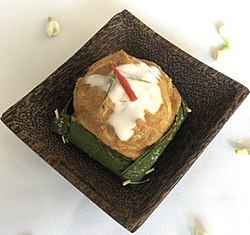Fish amok
 Fish amok served in a banana leaf container | |
| Alternative names | Amok trei, amok trey |
|---|---|
| Type | Steamed curry |
| Place of origin | Cambodia[1][2][3] |
| Serving temperature | Hot |
| Main ingredients | Goby fish, snakehead fish or catfish, yellow or green kroeung, coconut cream or coconut milk, eggs |
| Variations | ,[2] |
Fish amok or amok trei (Khmer: អាម៉ុកត្រី [ʔaːmok trəj]) is a Khmer steamed fish curry (amok) with a mousse-like consistency, one of Cambodia's national dishes. Fish amok is believed to have been a royal Khmer dish dating back to the Khmer Empire,[1][2] athough others question it originating in Cambodia.[4]
Ingredients[]
Usually, goby fish, snakehead fish or catfish is used, however, they are also sometimes substituted with cod, snapper, barramundi, salmon, whiting, or perch. The fish fillets are rubbed with or marinated in a freshly-made yellow or green kroeung[2] mixed with coconut cream or coconut milk and eggs. The curry mixture is placed in a banana leaf container with great morinda leaves at the bottom and steamed for around 20 to 30 minutes until the curry achieves a mousse-like consistency.[2] Great morinda leaves can also be substituted with swiss chard leaves if not available.[5]
Fish amok is served hot usually in either banana leaf containers or coconut shells and eaten with steamed rice.[2] Many restaurants in Cambodia also serve less traditional versions of amok with chicken, tofu, or beef instead of fish. Other deviations include the use of a store-bought herb paste, other types of kroeung, more liquid consistency and cooking instead of steaming.[6]
See also[]
- , Thai variation of the dish
- , Lao variation of the dish
References[]
- ^ a b Gillan, Audrey (7 September 2017). "Cambodia: the art of amok". National Geographic. Retrieved 4 October 2019.
- ^ a b c d e f Dunston, Lara. "Cambodian Fish Amok Recipe – an Authentic Steamed Fish Curry in the Old Style". Grantourismo Travels. Retrieved 4 October 2019.
- ^ "Michelin-starred chef David Thompson explains his growing love for Cambodian cuisine". Aqua Expeditions. June 13, 2019. Retrieved May 26, 2021.
If the description of fish amok sounds like Thai cuisine (arguably the most popular Southeast Asian cuisine in the world), that’s because many elements of today’s Thai cooking was influenced by Khmer cooking techniques and principles perfected over centuries. (...) A dish that exemplifies Khmer influence, is fish amok, a steamed snakehead fish curry that is redolent of lemongrass, galangal and coconut aromas.
- ^ Lees, Phil (May 25, 2007). "The Dish: Fish Amok". The Wall Street Journal. Retrieved 7 October 2019.
The origins of fish amok are a source of regional debate. Dishes of this kind aren't unique to Cambodia. Malaysia and Indonesia boast the similar otak otak and Thailand cooks a spicier hor mok but neither nation embraces them with the passion of Cambodia. "Amok" in the Cambodian language, Khmer, only refers to the dish whereas in Thai, "hor mok" translates as "bury wrap," suggesting amok may have come from Cambodia's neighbor.
- ^ Rivière, Joannès (2008). Cambodian Cooking: A humanitarian project in collaboration with Act for Cambodia. Periplus Editions. p. 55. ISBN 978-0-794-65039-1.
- ^ Carter, Terence. "Ruining Amok, The Corruption of Cambodia's National Dish". Grantourismo Travels. Retrieved 7 October 2019.
External links[]
| Wikimedia Commons has media related to Fish amok. |
- Amok Trei/Fish Amok. 1 May 2021. Cambodianess.
- Make Amok, Fish Curry Steamed In Banana Leaves. 25 April 2021. Munchies. Vice Media via YouTube
- Rachel Gray. Everything you ever wanted to know about Cambodian fish amok. February 2019. Jetstar
- Southeast Asian curries
- Cambodian cuisine
- Curry dishes
- Fish dishes
- Steamed foods